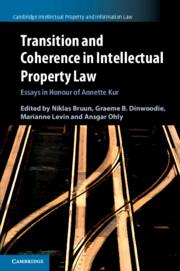
-
Select format
-
- Publisher:
- Cambridge University Press
- Publication date:
- December 2020
- January 2021
- ISBN:
- 9781108688529
- 9781108484602
- 9781108723367
- Dimensions:
- (228 x 152 mm)
- Weight & Pages:
- 0.9kg, 532 Pages
- Dimensions:
- (229 x 152 mm)
- Weight & Pages:
- 0.76kg, 532 Pages
- Series:
- Cambridge Intellectual Property and Information Law (55)
- Subjects:
- Intellectual Property, Law, Comparative Law, International Trade Law
You may already have access via personal or institutional login- Series:
- Cambridge Intellectual Property and Information Law (55)
- Subjects:
- Intellectual Property, Law, Comparative Law, International Trade Law
Book description
The nature and content of intellectual property (IP) law, which is heavily contingent on the state of technology and on social and market developments, has always been subject to ongoing transitions. How those transitions are effected and the shape they take is crucial to the ability of IP to achieve its stated goals and provide the necessary climate for investment in creativity, innovation and brand differentiation. Yet the need for change can run headlong into a desire for coherence. A search for coherence tests the limits of the concept of “intellectual property,” is imperiled by overlaps between different IP regimes, and calls for a unifying normative theme. This volume assembles contributors from across IP and the globe to explore these questions, including whether coherence is desirable. It should be read by anyone interested in understanding the conceptual underpinnings of one of the most important and dynamic areas of the law.
Contents
Metrics
Full text views
Full text views help Loading metrics...
Loading metrics...
* Views captured on Cambridge Core between #date#. This data will be updated every 24 hours.
Usage data cannot currently be displayed.
Accessibility standard: Unknown
Why this information is here
This section outlines the accessibility features of this content - including support for screen readers, full keyboard navigation and high-contrast display options. This may not be relevant for you.
Accessibility Information
Accessibility compliance for the PDF of this book is currently unknown and may be updated in the future.


